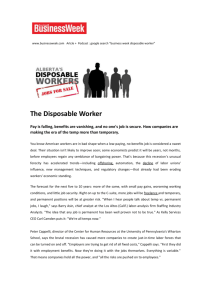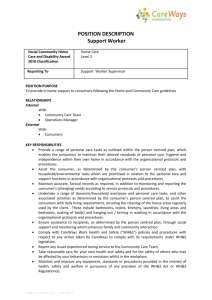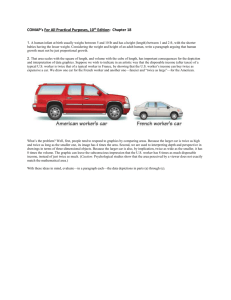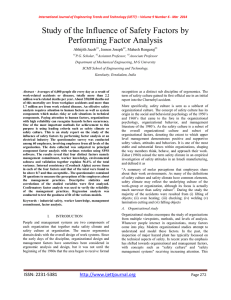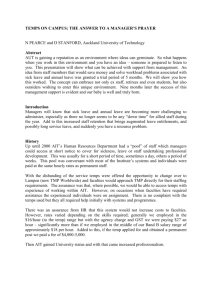Permanent vs Temp staff
advertisement
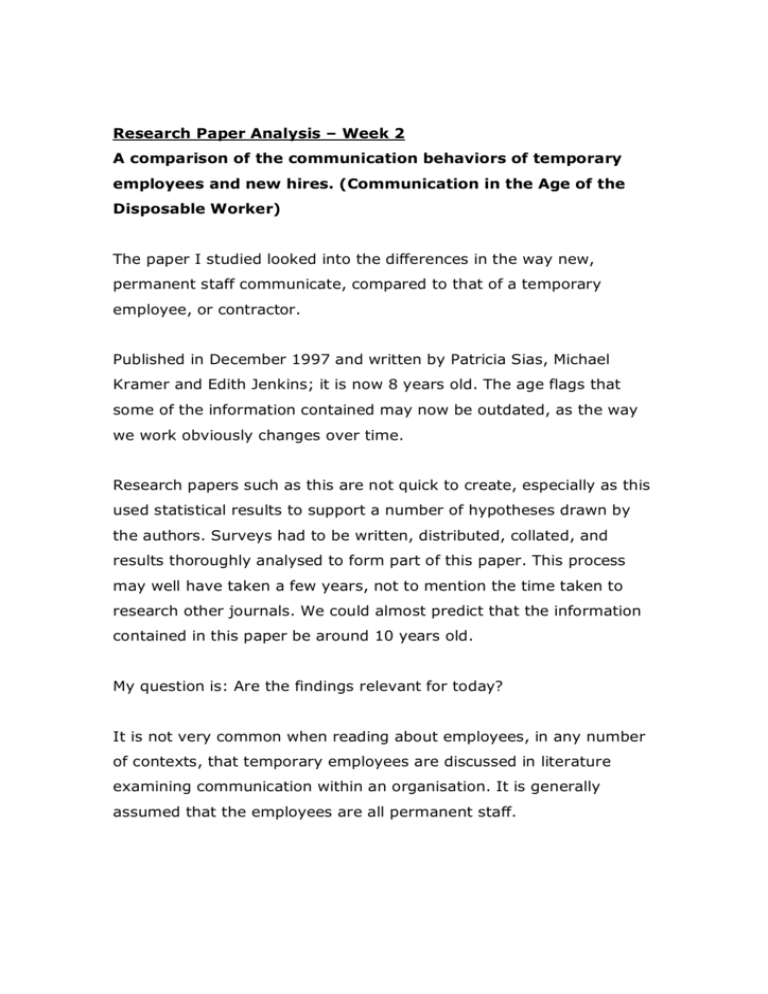
Research Paper Analysis – Week 2 A comparison of the communication behaviors of temporary employees and new hires. (Communication in the Age of the Disposable Worker) The paper I studied looked into the differences in the way new, permanent staff communicate, compared to that of a temporary employee, or contractor. Published in December 1997 and written by Patricia Sias, Michael Kramer and Edith Jenkins; it is now 8 years old. The age flags that some of the information contained may now be outdated, as the way we work obviously changes over time. Research papers such as this are not quick to create, especially as this used statistical results to support a number of hypotheses drawn by the authors. Surveys had to be written, distributed, collated, and results thoroughly analysed to form part of this paper. This process may well have taken a few years, not to mention the time taken to research other journals. We could almost predict that the information contained in this paper be around 10 years old. My question is: Are the findings relevant for today? It is not very common when reading about employees, in any number of contexts, that temporary employees are discussed in literature examining communication within an organisation. It is generally assumed that the employees are all permanent staff. But what of temporary staff? How does their communication differ to permanent employees? The paper reports that, at that time, the number of temporary workers in the US had doubled over the past 5 years prior to the paper being written - And that was 8 years ago. So what has happened in the 8 years since the paper was written? Has population of the temporary worker doubled again, or have the majority secured permanent jobs? The National Bureau of Economic Research suggested in its paper “Temporary Workers Raise Manufacturing Productivity Measure”, that “In the last 10 years or so, employment in the U.S. "temporary help supply" industry has more than tripled.” From this, we can draw that the findings in this paper are still relevant for today, and that organisations should be looking at ways to harness the contingent workers’ skills, in order to benefit both parties. That means, being aware of the different ways employee types communicate. In another study that took place around 8 years ago, it was found that temporary staff are often physically and socially isolated from other workers. This obviously suggests that the communication experiences of temporary workers are significantly different from those permanent employees. This study delves into deep levels of communication comparisons, often using statistical information gathered, as evidence, in very technical terms. This information may have been better placed at the tail of the paper as personally, it served as a distraction to what the whole point of the paper was about. Most of the time reading was spent trying to sift through the statistical babble for meaningful findings. From what I was able to understand, both of these types of employees are newcomers to their organizations, and the paper examined the differences in their information-seeking and information-giving behaviors, providing insight into the unique communication experiences of temporary employees. The study also examines the relationships between communication and job satisfaction, role ambiguity, perceived performance, and communication knowledge to explore the impact of the communication experiences on these employees. The study states that employees use two different ways to seek information to reduce uncertainty: direct and indirect. An important factor influencing the type of information seeking strategy used by newcomers is the perceived social cost of using the particular strategy. If individuals perceive that seeking information may damage their public image, then they will be less inclined to seek out that information. We see this being illustrated in our day-to-day life. In a lecture, students may tend to feel that their interactivity with a Lecturer may, damage their public image in potentially two ways: being seen as a ‘nerd’ by providing a valuable insight, or simply getting wrong in front of their peers. If you were a temporary worker however, the paper highlights that when seeking information, you would be much less concerned about how you looked to other people, as you would be gone soon anyway. It is also argued that temporary workers are less likely to interact with other organisational members, as they know they will be leaving the organization in a relatively short period of time. The differences between the US and Australia on this topic has not been ascertained. Or perhaps my workplace is unlike the majority. I have found that temporary workers, act, and are treated like any other permanent employee. As a result of this, the temporary employee, or contractor, uses words such as ‘we’, as if they were permanent staff. The study also talks about temps not receiving regular feedback, which I have found to be different in my department. All staff have a fortnightly ‘one-on-one’ with their acting manager, where feedback works both ways and acts as an open platform to voice concerns or otherwise. This happens to both permanent and temporary staff. The study states that, quote “Performance evaluations are of limited value to temporary employees, but are critical for regular employees to assess their organisational success.” I rebut this point because temporary employees are always learning, just like everyone else. They also need information for their future personal development. If they are doing something wrong, or could be doing it better and are not told, then they are just going to be carrying on doing it and not knowing, which may result in work being done slower and ultimately them being given a bad name and future work opportunities compromised. People take temporary work instead of permanent for three main reasons: 1) Enjoy the flexibility of work hours and holiday times 2) To explore career options in a particular field 3) Because they want to be immersed in the organization in the hope that they may get offered a permanent position. If we go back to the findings of the study, that permanent and temporary staff communicate differently, looking at the different kinds of temporary workers, the temporary worker that wants to be involved and ‘get their foot in the door’ of the company closely mimics the communication of a permanent worker, whereas the workers motivated by the other two options display different behaviors. The statistics in this study indicated that temporary employees were asked for information less frequently and provided unsolicited information less frequently. This finding is consistent with other research showing that temporary employees tend to be physically and communicatively isolated from permanent employees in the workplace. It also points out that temps tend to become invisible organisational members. This statement is also backed up by the paper, “Temp staffing carries legal risk”, “At National Semiconductor, this training even goes down to office socializing. "Some of the stuff may be hard to swallow, like not inviting them for the department birthday cake or picnic, and you're working right next to these people," says Gray. "But you have to do it." ” Although temporary workers are not typically viewed as important contributors, they may actually have much to contribute to the knowledge and innovation of the organization. It is time that we started calling them one of “our own”. Bibliography Sias et al. (1997). A comparison of the communication behaviors of temporary employees and new hires. (Communication in the Age of the Disposable Worker) Communication Research, 24, 6, 731-756. Davidson, L. (1997). The temp pool's shrinking. Workforce, 76, 4, 7277. Flynn, G. (1999). Temp staffing carries legal risk. (potential legal problems in temporary employment). Workforce, 78, 9, 56-62. Economist Newspaper Ltd. (2003). Money well spent; Corporate parties. The Economist (US), 369, 8348, 59. Temporary Workers Raise Manufacturing Productivity Measure. (post 1997). [On-line]. Accessed on 07 August, 2005 on the World Wide Web: http://www.nber.org/digest/apr00/w7421.html


